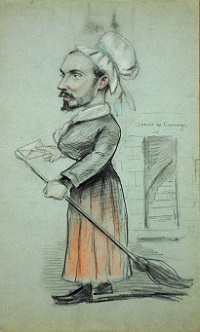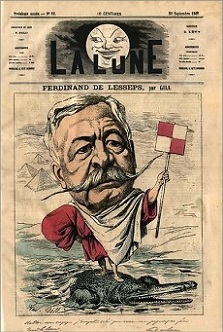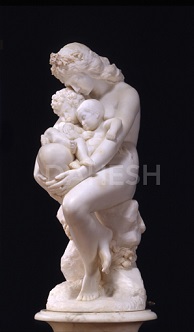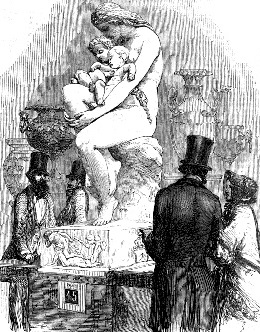The 19th century advancements in printing led to the rapid emergence of illustrated newspapers and journals, which helped promote a new genre of art––reportage. Encompassing depictions of military struggles, politics, caricatures, and celebrities, reportage art reached new middle and lower-class audiences through papers like the Illustrated London News (1842–2003) and L’Illustration (1843–1944).
Invented in 1796, lithography was the first technology for mass printing illustrations to be incorporated into weekly publications. Lithographs, printed as separate sheets and then folded into papers, were instrumental in popularizing caricatures, lampoons of well-known persons or types that appeared in journals such as La Silhouette (1829–1831) and La Caricature (1830–1843). Guillon’s Caricature of a Sculptor is a humorous depiction indebted to André Gill’s “big-headed” caricatures that were popular in La Lune (1865–1868)—see the September 29, 1867 cover, for instance, above center. While the humor mostly derives from the drawing’s proportions, Guillon has hidden another joke in the image; on the table behind the sculptor rests a bust of a woman, whose ample bosom suggests an indecorous side to the gentleman.
Though end grain wood-engraving had been invented in the late 18th century by Thomas Bewick, it only became a feature of the press after the Illustrated London News adopted the medium in 1842. In this technique, an image is incised onto hardwood and then transferred to a metal plate using a mold. These plates were clamped into the same frame that the letterpress used, meaning that text and images could be printed side-by-side for the first time. Not only could wood-engravings be printed alongside text, a major advantage over lithographs, but they were also incredibly detailed. This made it easy to reproduce works of fine art, such as August Hyacinth Debay’s famous sculpture The First Cradle: Eve and Her Two Children, which was shown in London at the Great Exhibition of 1851 and then reproduced in The Illustrated London News on October 11, 1851 (above right)
Although Nicéphore Niépce invented photography in 1826 or 1827, photographs only became a regular feature of the press after the technology greatly improved and the half tone printing process was developed in the 1880s. Even then, engravings were still common––the Polish artist Antoni Piotrowski, for instance, saw his drawings of the Serbo-Bulgarian War of 1885 printed in the Illustrated London News and Le Monde Illustré (1857–1940 and again 1945–1956). But as printing and photography both improved, it gradually superseded engraving, and publications dedicated to reproducing photographs emerged, such as the Galerie Contemporaine, a compendium of celebrity photogravures. Despite this, reportage illustrations lived on as late as the 1920s, as a handful of artists were used to report on social events.






